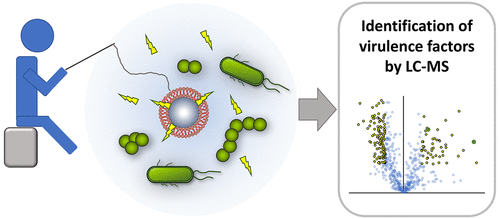Our official English website, www.x-mol.net, welcomes your feedback! (Note: you will need to create a separate account there.)
Tools for Pathogen Proteomics: Fishing with Biomimetic Nanosponges
ACS Nano ( IF 17.1 ) Pub Date : 2017-11-20 00:00:00 , DOI: 10.1021/acsnano.7b07363 Ute Distler 1 , Stefan Tenzer 1
ACS Nano ( IF 17.1 ) Pub Date : 2017-11-20 00:00:00 , DOI: 10.1021/acsnano.7b07363 Ute Distler 1 , Stefan Tenzer 1
Affiliation

|
The identification of the major virulence factors that drive pathogenicity is critical for gaining insight into the underlying molecular mechanisms of diseases. Although genetic approaches combined with functional analyses have markedly increased the rate of virulence factor discovery, the divergence between genome and proteome can impair the identification of important markers, in particular, of those that act in concert or depend on specific environmental factors. Recently, membrane-coated nanomaterials mimicking source cells of interest have emerged as powerful tools that can be used for improved tumor targeting and as “nanotraps” to capture chemokines and bacterial toxins. In this issue of ACS Nano, Lapek et al. demonstrate that membrane-coated nanosponges in combination with quantitative proteomics can also be used as efficient “fishing devices” for the identification of cell-type-specific virulence factors.
中文翻译:

病原蛋白质组学的工具:用仿生纳米海绵钓鱼
识别引起致病性的主要毒力因子对于深入了解疾病的潜在分子机制至关重要。尽管遗传学方法与功能分析相结合已显着提高了毒力因子的发现率,但基因组和蛋白质组之间的差异可能会损害重要标志物的识别,特别是那些协同作用或依赖于特定环境因素的标志物的鉴定。最近,模仿目标细胞的膜涂层纳米材料已经成为功能强大的工具,可用于改善肿瘤靶向性,并作为“纳米陷阱”来捕获趋化因子和细菌毒素。在本期ACS Nano中,Lapek等人。 证明膜包裹的纳米海绵与定量蛋白质组学结合还可以用作鉴定细胞类型特异性毒力因子的有效“捕捞装置”。
更新日期:2017-11-20
中文翻译:

病原蛋白质组学的工具:用仿生纳米海绵钓鱼
识别引起致病性的主要毒力因子对于深入了解疾病的潜在分子机制至关重要。尽管遗传学方法与功能分析相结合已显着提高了毒力因子的发现率,但基因组和蛋白质组之间的差异可能会损害重要标志物的识别,特别是那些协同作用或依赖于特定环境因素的标志物的鉴定。最近,模仿目标细胞的膜涂层纳米材料已经成为功能强大的工具,可用于改善肿瘤靶向性,并作为“纳米陷阱”来捕获趋化因子和细菌毒素。在本期ACS Nano中,Lapek等人。 证明膜包裹的纳米海绵与定量蛋白质组学结合还可以用作鉴定细胞类型特异性毒力因子的有效“捕捞装置”。



























 京公网安备 11010802027423号
京公网安备 11010802027423号